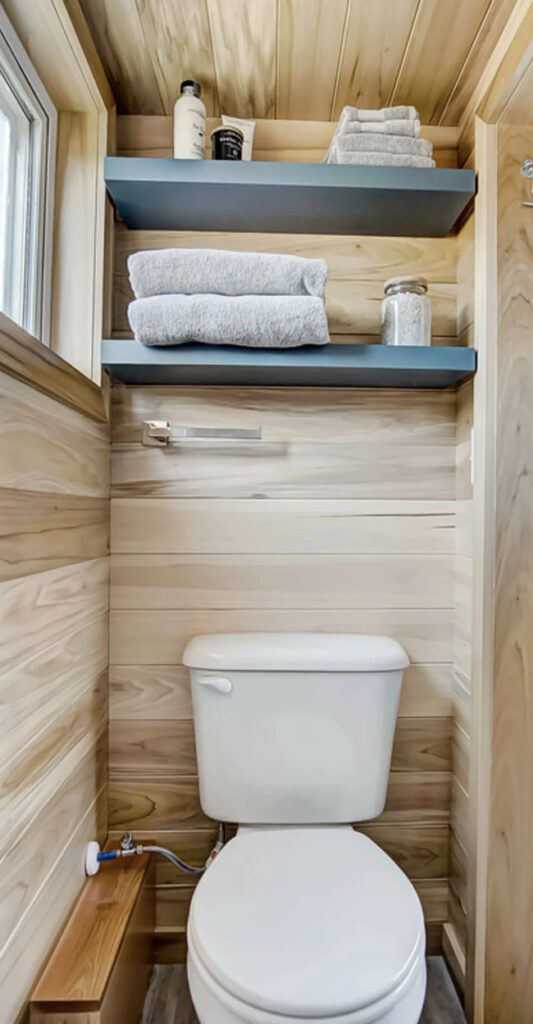
The Buxton Tiny Home stands as a beacon for those enamored with a nomadic lifestyle, offering a cozy haven on the move. Crafted by Modern Tiny Living, its ingenious design optimizes space, making it ideal for both frequent travelers and those seeking a compact guesthouse or full-time residence. Aptly named after the picturesque Buxton lighthouse in California, this diminutive dwelling measures a modest 20 feet in length and boasts a price tag of $79,000. Despite its petite stature compared to conventional North American homes, the Buxton doesn’t compromise on comfort. Mounted on a double-axle trailer, it sports an exterior of engineered wood complemented by a durable steel roof, ensuring durability during travels. Powered via a standard RV-style hookup, its interior exudes a sense of airiness thanks to ample glazing, while poplar tongue-and-groove paneling paired with vinyl flooring offers a warm aesthetic.

Stepping inside, the living room greets occupants with a versatile sofa bed, providing snug accommodations for two along with integrated storage solutions. A mini-split air conditioning unit maintains an optimal climate, ensuring year-round comfort. Seamlessly connected to the living area, the kitchen showcases stainless steel countertops, cabinetry, and a compact yet functional layout, complete with a sink and mini-fridge. The adjacent bathroom, though compact, features a shower and flushing toilet, meeting essential needs within the confines of its space. Ascending the storage-integrated staircase reveals the sole bedroom, characterized by a double bed nestled beneath a low ceiling, reminiscent of loft-style designs prevalent in tiny homes. Flexible in its design, the Buxton Tiny Home offers customization options to suit individual preferences, allowing for adjustments in appliances, materials, and layout to accommodate diverse lifestyles.









In a groundbreaking endeavor set to revolutionize the energy landscape, Finland prepares to harness waste heat generated from electronics to combat its frigid winters. Nestled near Helsinki, the world’s largest seasonal energy storage facility is poised for construction, boasting cavernous underground reservoirs capable of storing vast thermal energy reserves. Spearheaded by the Varanto project in Vantaa, Finland’s fourth-largest city, this innovative initiative aims to leverage waste heat from data centers, cooling processes, and waste-to-energy facilities, channeling it into underground caverns for later use in heating buildings via the district heating network. With Finland’s substantial fluctuations in heat consumption between seasons, this visionary project offers a sustainable solution to the challenge of storing energy efficiently, serving as a beacon of hope in the global transition towards clean energy.

Led by Vantaa Energy CEO Jukka Toivonen, the Varanto project exemplifies Finland’s commitment to pioneering large-scale energy storage solutions in the face of climate change. With caverns spanning an area equivalent to two Madison Square Gardens and capable of sustaining water temperatures of up to 300 degrees Fahrenheit without boiling, this monumental endeavor promises to heat a medium-sized Finnish city for an entire year. By coupling renewable electricity with thermal energy reserves, Varanto embodies a hybrid approach to energy production, maximizing efficiency and sustainability. With substantial investment and governmental support, this ambitious venture not only sets a new standard for energy storage but also underscores the pivotal role of district heating networks in Finland’s sustainable energy future.

At 81 years old, Josephine Michaluk stands as a testament to unwavering compassion and selflessness. Her journey began nearly six decades ago, sparked by a simple act of accompanying her sister to a blood donation appointment. Since then, she has dedicated herself to the noble cause of donating blood, a commitment that has earned her the esteemed title of the world record holder for the most units of blood donated in a lifetime. With each pint she gives, she offers a glimmer of hope to someone in need, embodying the spirit of altruism in its purest form.

Michaluk’s remarkable contributions extend beyond mere numbers, as her O+ blood type holds a crucial significance in the medical community. With its universal compatibility, her donations have the potential to save countless lives, reinforcing the vital supply of blood for hospitals and health facilities. Despite the rigorous physical evaluations preceding each donation, Michaluk remains undeterred, finding solace in the revitalizing effect of her actions. Her story serves as an inspiration, a reminder of the profound impact that one individual can have on the world by lending a helping hand to those in need. As she presses forward with her mission, Michaluk continues to challenge others to join her in the noble pursuit of saving lives, a testament to the power of compassion and solidarity in building a brighter future for all.

In the quaint countryside of Vermont, a remarkable transformation has unfolded thanks to the innovative spirit of Jonathan Yacko and Natalie Gilliard. Exhausted by the ceaseless task of mowing their expansive lawn, the couple decided to embrace change and swapped out the monotonous chore for a vibrant meadow of wildflowers. What began as Continue reading “Millions of Wildflowers Now Delight the Town After Vermont Couple Got Tired of Mowing the Lawn All Day” »

The annual survey conducted by the US Fish and Wildlife Service revealed promising results for the wild population of Mexican wolves in 2023. With a minimum count of 257 wolves across Arizona and New Mexico, this marks the eighth consecutive year of population growth, showcasing the continued success of recovery efforts. Jim deVos, the Mexican Wolf Coordinator at the Arizona Game and Fish Department, highlights the significant strides made since the inception of recovery initiatives, emphasizing the expansion of wolf territories and the positive outcomes of genetic management through fostering programs. The data underscores a hopeful trajectory for Mexican wolf recovery, buoyed by a decade of steady progress.

The fostering efforts in 2023 have proven particularly fruitful, with a minimum of 15 fostered Mexican wolf pups reaching breeding age and at least 10 successfully breeding in the wild. Brady McGee, the U.S. Fish and Wildlife Service Mexican Wolf Recovery Coordinator, applauds the diverse array of successes in the recovery endeavors, noting the crucial role of genetically diverse wolves in bolstering the wild population. The collaborative efforts of government agencies, conservationists, and wildlife experts have been instrumental in safeguarding the Mexican wolf, a subspecies listed as endangered under the federal Endangered Species Act. From the brink of extinction, the Mexican wolf has experienced a remarkable resurgence, owing much to the dedication of individuals like Rory T. McBride, whose transition from trapper to conservationist has left an indelible mark on the preservation of these magnificent creatures.

In the picturesque landscape of Bali, the harsh reality of a plastic pollution crisis lurks beneath the surface, overshadowing its natural beauty. With a staggering 1.6 million tons of waste generated annually on the island and the additional burden of debris from neighboring shores, the ecological balance of its waters is under threat. However, amidst this environmental challenge, a beacon of hope emerges as two dedicated organizations join forces to tackle the issue head-on. Through the collaborative efforts of Sungai Watch and Sungai Design, Bali’s waterways are undergoing a transformative journey from polluted to pristine, with reclaimed plastic finding new life as sleek and contemporary loungers.

Sungai Watch initiates the cleanup process by strategically identifying and targeting rivers plagued by pollution, and deploying innovative barriers to capture and contain the waste. Since its inception in 2020, the nonprofit has made significant strides, extracting a remarkable 1,718,562 kilograms of plastic from Bali’s watercourses. Once retrieved and meticulously sorted, the plastic undergoes a metamorphosis at the hands of Sungai Design. Through a sophisticated process of shredding and pressing, the material is molded into large panels, which are then transformed by CNC machines into stylish and functional chairs. Not only do these loungers epitomize modern design, but they also embody sustainability, with each chair repurposing an estimated 30 kilograms of plastic, offering a tangible solution to Bali’s environmental crisis. For those intrigued by the journey from pollution to product, a delve into Sungai Design’s YouTube channel provides an illuminating insight, while the opportunity to support the cause and own a piece of eco-conscious furniture is just a click away.






In recent years, the discourse surrounding sustainable food sources has prominently featured insect protein as a viable alternative, sparking curiosity and skepticism alike. However, a pioneering startup in the UK, Entocycle, has risen to the challenge by ingeniously integrating insects into the food supply chain. Their innovative approach not only mitigates emissions but also addresses concerns regarding digestibility. Entocycle, now in its ninth year of operation, leverages the nutritive potential of black soldier fly larvae to substitute traditional animal feeds like corn, soy, and fishmeal for poultry and swine.

The decision to focus on poultry and swine, both monogastric animals, aligns with Entocycle’s vision to emulate natural dietary patterns. While these animals have historically been fed agricultural products, the startup acknowledges the evolutionary significance of insects in their diets. At its development facility in London, Entocycle meticulously cultivates black soldier fly larvae, utilizing their voracious appetite for organic waste to convert it into high-quality protein feed. Beyond environmental benefits, this approach holds promise for waste management, offering a sustainable solution to food scraps destined for landfills. Entocycle’s founder, Keiran Whitaker, champions the versatility and ubiquity of black soldier flies, highlighting their capacity to revolutionize animal agriculture while addressing pressing environmental concerns. Moreover, scientific research underscores the manifold advantages of incorporating insect protein into animal diets, from enhancing growth performance to improving meat quality, thus reinforcing the viability of this innovative solution in the quest for sustainable food production.

In the lush and remote reaches of India’s Western Ghats, biologist Ishan Agarwal stumbled upon a mesmerizing sight: a stunning blue and yellow gecko that seemed to dance amidst the foliage. Captivated by its beauty, Agarwal immediately thought of Vincent Van Gogh’s iconic painting, Starry Night. Thus, he decided to pay homage to Continue reading “Biologist Finds Beautiful Blue Gecko, Named the New Species ‘Vangoghgi’” »

The Luffa Stoolita project, born from the innovative minds of master’s students at Columbia University GSAPP, Justin Wan, Paul Edward Liu, and Tim Ting-Hao Chen, transcends traditional furniture design paradigms by repurposing natural waste materials. By ingeniously utilizing spent shower sponges and coffee grounds, the team explores the potential of plant-based by-products, challenging the norm in sustainable furniture creation. With a keen eye on environmental responsibility, Continue reading “From Chow to Chair: Upcycled Stools Made From Spent Shower Sponges and Coffee Grounds” »













































